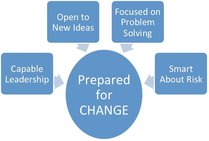RM Dinosaurs versus the Captains of Change – which one are you?
Revenue management has evolved and each year there are new developments, new improved systems and new features. Some organisations are set up to exploit these innovations but some are not, writes Tom Bacon, in this exclusive guest article for EyeforTravel.com.
So what exactly does it take for an RM organisation to keep up with scientists? Is your organisation poised for change – or are you more like a dinosaur?
In fact there are four key characteristics that define a change-oriented RM group: leadership, openness, problem solving and being smart about risk. Many organisations lack all of these; most lack at least one of these. However, when you think about implementing ‘the latest and greatest’, you need to consider these four prerequisites. When you strive to be at the forefront in revenue management, ensure your organisation is a properly positioned to tackle each of these.

Now let’s take a closer look at these four elements. In each I spell out both ‘the model’ - or what I believe your organisation should aspire to, and ‘the dinosaur’, which defines an organisation not poised for change. Here goes:
1. Leadership.
The Model: Revenue management leadership starts at the top. Since revenue management often touches every aspect of the business – the product, positioning, sales and marketing, distribution, customer service and delivery – a change-oriented RM organisation needs a leader who sees the big picture and appreciates the value of pricing science. Although they do not need to understand all of the technical aspects, they do need to have a clear understanding of the relationship of pricing to the other aspects of the business and they need to champion the science within the broader organisation. Essentially, RM needs to be considered a strategic element of the business, not a technical silo.
The Dinosaur: If the organisational leader is more oriented toward other specialised functions - marketing or sales or distribution – RM will likely suffer. RM frequently has conflicts with the other functions as it seeks to allocate capacity, sell-up, and maximise RASM. As changes in RM are sometimes highly technical and therefore more difficult to understand, a weak RM leader will be held back from change as the impacts on the rest of the organisation present political hurdles.
2. Openness
The Model: Revenue management departments that are poised for change are open to learning more and capitalising on what the scientists are discovering. The best RM departments ‘know what they don’t know’. They recognise that, despite all their successes, they still need to continually adapt to a changing marketplace and to stay ahead of competitors – which also are likely not standing still.
The Dinosaur: Some RM departments discount new discoveries by RM suppliers. Often, their RM departments are positioned to be more market-oriented than science oriented. They overvalue their individual airline’s experience and too frequently override what the RM system advises anyway. They operate in silos as highly technical groups who are managing revenue in a ‘black box’. They can’t afford to admit to the rest of the organisation (the sales folks, marketing, operations) that they don’t know it all. They don’t tend to be oriented toward industry analysis or broader industry experience since their airline situation is ‘unique’.
3. Problem solving
The Model: Obviously, it’s easier to adopt a change, if it responds directly to an issue the organisation faces. The ‘Low Fare Manager’ module of a major airline RM vendor responds to many a legacy carrier’s experience with the downward spiral of fares they face in competition with low cost airlines. Monitoring other competitor prices via data solutions like ql2 or InFare help travel companies better understand competitive availability. A group module helps manage a subset of customers that require special (RM and administrative) handling. Leaders in RM, of course, often influence what the RM suppliers work on, so, when a new solution is ready, these travel firms are positioned to implement.
The Dinosaur: On the other hand, many companies don’t understand that they have a problem. They are content with the status quo – perhaps they have their hands full just managing what they’ve got. They tend to think of the enhancements as more sophisticated than they need.
4. Smart about risk
The Model: Any travel firm, even the leaders in RM technology and sophistication, need to recognise the risk in managing change. They need to formulate project plans around any enhancement, including proper testing, clear goals and ongoing metrics. While open to the opportunities presented by the latest enhancement, they need to also be cognisant of the limitations of RM science and the sometimes high sensitivity of sophisticated modeling to small errors. The leaders in RM approach change prudently.
The Dinosaur: Many airlines believe they can be prudent about risk by minimising change. Of course, this is sometimes actually the most risky position – to not change when the marketplace demands it. Many airlines, naturally, would rather retain the ‘status quo’ (the devil they know!).
To sum up then, for an RM organisation to be change oriented means much more than having the budget to purchase the latest RM enhancement. There are four features of RM organisations properly positioned for change. Before you purchasing the next enhancement, you should review how your organisation matches up against the four factors.
This article was penned by Tom Bacon, a former airline executive and industry consultant in revenue optimisation. His views are his own. Questions? Contact Tom at tom.bacon@yahoo.com.

